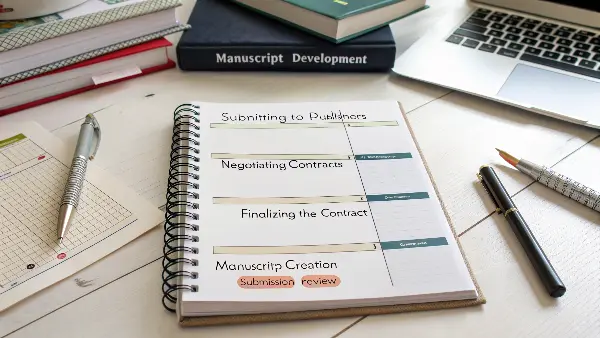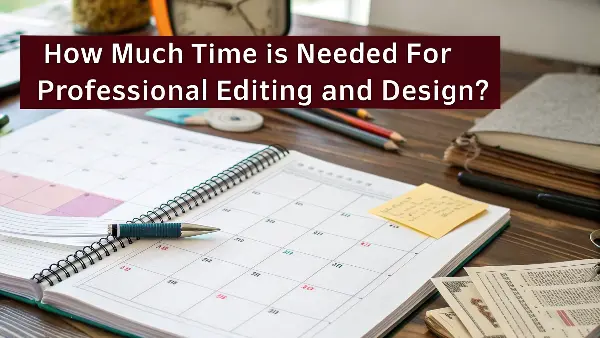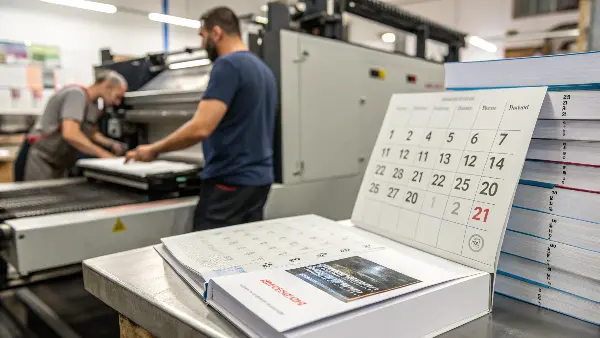Planning to publish a book can feel overwhelming, with timelines that seem vague and confusing. You worry that underestimating the schedule will lead to missed launch dates, budget problems, and a lot of stress. The key is to have a clear roadmap of the entire process so you can navigate it with confidence.
A complete book production timeline, from the initial idea to the final delivery, generally ranges from 9 months to over two years. This wide range depends on many factors. These include manuscript readiness, the depth of editing required, the chosen printing methods, and global shipping logistics. The main phases are manuscript development, editing, design, printing, and distribution, each with its own schedule.
The journey from a simple manuscript to a professionally published book is long and has many steps. It requires careful planning and a good understanding of each stage. Breaking down the process helps you see where potential delays might happen and how to manage them. By looking at each phase one by one, you can build a realistic timeline, set achievable goals, and work more effectively with your partners, whether they are editors, designers, or printers like us. Let’s dive into the details of each major step to give you a clear picture of the path ahead.
What Are the Key Pre-Production Stages and How Long Do They Take?
You have a fantastic idea for a book, but turning it into a polished manuscript and securing a publishing deal seems like a huge task. You might worry about getting stuck in endless writing cycles or confusing contract talks. Let’s clear up these first steps so you can start your project with a solid plan.
The pre-production phase, which covers manuscript development, submitting it to publishers, and negotiating a contract, can take from a few months to over a year. Creating the manuscript itself is the most variable part, often taking months. The submission and review process usually adds another one to four months. After that, finalizing the contract typically takes around two more months before any production can begin.

The pre-production phase is where your book project is born and takes shape. It’s a critical period that lays the foundation for everything that follows. Rushing through these initial steps can lead to problems later on, so it’s important to give each part the time it needs. I’ve seen many projects get delayed because the initial manuscript wasn’t ready or the contract details weren’t fully sorted out. Taking the time to get this right will make the entire publishing process much smoother.
The Creative Spark: Manuscript Development
This is often the longest and most unpredictable part of the entire timeline. For an author, it involves more than just writing. It includes research, outlining, writing the first draft, and then going through several rounds of self-editing. Depending on the complexity of the subject, this stage can take anywhere from three months to a year, or even longer. For businesses like ours that create custom notebooks or planners, this phase is similar. It involves market research, concept design, and creating detailed specifications before we even think about production.
Finding a Partner: Submission & Review
Once the manuscript is ready, the next step is to find a publisher. This involves sending out query letters, proposals, and sample chapters. Publishers receive hundreds of submissions, so the review process takes time. It can take anywhere from one to four months to get a response. Their team needs to read the submission, decide if it fits their brand, and evaluate its market potential. It’s a waiting game, but a necessary one.
Making It Official: Contract Negotiation
If a publisher is interested, they will offer a contract. This part of the process typically takes about two months. It involves a lot of back-and-forth between the author (or their agent) and the publisher’s legal team. They discuss important details like the advance payment, royalty rates, publishing rights, and, crucially, the final manuscript delivery deadlines. It’s vital that all parties are clear on these terms before moving forward.
Here’s a simple table to summarize these stages:
| Pre-Production Stage | Average Duration | Key Activities |
|---|---|---|
| Manuscript Development | 3–12+ months | Research, writing, self-editing, getting feedback |
| Submission & Review | 1–4 months | Querying publishers, waiting for committee review |
| Contract Negotiation | 2 months | Reviewing terms, legal checks, signing the deal |
How Much Time Is Needed for Professional Editing and Design?
Your manuscript has been accepted, which is great news. But now it needs to be transformed from a simple document into a beautifully designed, error-free book. This stage can seem long and complicated, and you worry that any delays here could mess up your entire launch schedule. Let’s walk through it together.
The professional editing and design phase can take up to 18 months, but simpler projects might be much faster. This essential stage includes multiple rounds of editing, such as developmental, copyediting, and proofreading, which alone can last 6 to 9 months. After the text is finalized, the cover design, interior layout, and typesetting take another 3 to 6 months to get the book ready for the printer.

This is the stage where the raw material of your manuscript is shaped and polished into a professional product. It involves a team of specialists, from editors who refine your words to designers who create the visual identity of your book. In my experience working with clients like Michael from Germany, who has a keen eye for detail, this phase is all about quality control. He understands that a well-edited text and a compelling design are what make a product stand out in a crowded European market. Rushing this process is a mistake we always advise against.
Polishing the Words: The Editing Cycle
Editing happens in several distinct rounds. First is developmental editing, where an editor looks at the big picture: the book’s structure, flow, and overall argument. This can involve major revisions and take a few months. Next comes copyediting, which focuses on grammar, spelling, punctuation, and consistency at the sentence level. After the layout is done, the final step is proofreading, which is a last check for any typos or formatting errors before printing. I remember a client who skipped the final proofread to save two weeks. They ended up finding a glaring typo on the back cover after 5,000 copies were printed, a costly mistake that could have been avoided.
Creating the Visuals: Design and Typesetting
While the text is being edited, the design process begins. This includes two main parts: the cover and the interior. Cover design is crucial for marketing. It involves research, brainstorming concepts, and multiple rounds of revisions to create something that grabs attention. Interior design, or typesetting, is about making the book easy and enjoyable to read. This includes choosing fonts, setting margins, and placing any images or tables. This process ensures the book not only looks good but also provides a great reader experience.
The Final Check: Approval and Pre-Press
Once the editing and design are complete, the publisher creates a final proof. This can be a digital PDF or a physical printed copy. The author and editorial team review this proof meticulously one last time. This is the last chance to catch any mistakes before the files are sent to the printer. This approval step is final. Once you say "go," the printing presses start rolling, and changes become very expensive, if not impossible.
What Does the Physical Printing and Binding Timeline Look Like?
Your book is perfectly edited and designed, and the final files are approved. Now, it’s time to turn those digital files into a physical book. You might be concerned about printing quality, manufacturing delays, or mistakes at the factory. Understanding this hands-on production timeline is key to managing your launch.
The physical printing and binding of a book typically takes between 4 and 12 weeks. This schedule depends heavily on the printing method you choose (offset or digital), the complexity of the book (like a hardcover versus a paperback), the size of your print run, and the printer’s current workload. Offset printing is better for large orders but has a longer setup time, while digital printing is faster for smaller batches.

As someone who manages a supply chain for stationery and books, this is my favorite part of the process. It’s where all the planning and creativity become a real, tangible product. We work closely with our printing partners to ensure every detail is perfect, from the paper quality to the crispness of the binding. It’s a precise process that requires careful coordination. Knowing the steps involved helps you understand why quality takes time and allows you to plan accordingly for a product you can be proud of.
Choosing Your Method: Offset vs. Digital Printing
The first big decision is the printing method. Offset printing uses plates to transfer ink to paper and is the standard for high-volume runs (usually over 1,000 copies). The setup is more time-consuming and costly, but the per-book cost is much lower for large quantities. Digital printing prints directly from digital files, like a sophisticated office printer. It has minimal setup time, making it faster and more cost-effective for small runs or print-on-demand services. The choice depends entirely on your business needs and order size.
The Factory Floor: From Plates to Pages
Once the method is chosen, the factory gets to work. For offset printing, this starts with making the printing plates, which can take a week. Then, the presses run, printing the book’s pages on large sheets of paper. These sheets are then folded into "signatures," which are small booklets of 16 or 32 pages. The entire printing and folding process can take anywhere from two to six weeks, depending on the length of the book and the size of the print run.
Bringing It Together: Binding and Finishing
After the pages are printed and folded, they move to the bindery. This is where the book is assembled. The most common methods are perfect binding (for paperbacks, where pages are glued to the spine) and case binding (for hardcovers, where signatures are sewn together and attached to a rigid cover). This stage can also include special finishing touches like foil stamping, embossing, or adding a dust jacket. These extra details add to the book’s premium feel but can also add one to two weeks to the production time.
Here’s a breakdown of the typical printing timeline:
| Printing Stage | Typical Duration | Key Factors Influencing Time |
|---|---|---|
| Pre-Press & Proofing | 1–2 weeks | File readiness, speed of final proof approval |
| Printing & Folding | 2–6 weeks | Print run size, offset vs. digital, press time |
| Binding & Finishing | 1–4 weeks | Binding style, hardcover vs. softcover, extras |
How Do Shipping and Logistics Affect the Final Delivery Date?
The books are finally printed and stacked neatly at the factory, but they are not in your warehouse yet. You’re likely feeling anxious about this last step: getting them from the production facility to your distributors. Shipping delays, customs holdups, and logistical issues can be a real headache and might threaten your planned launch date.
Shipping and logistics can easily add another 4 to 8 weeks to your total timeline, especially for projects involving international freight. This period accounts for careful packing, ground transport to the port, the ocean or air journey itself, customs clearance at the destination, and the final truck delivery to your warehouse. Ocean freight is cheaper but slower (3-6 weeks), while air freight is much faster (1-2 weeks) but costs significantly more.

This final leg of the journey is where our expertise in international trade really comes into play. We help clients navigate the complexities of global logistics every day. A smooth shipping process requires meticulous planning and flawless paperwork. Forgetting one document or making a small error can cause a container to be held up in customs for weeks, leading to missed deadlines and frustrated customers. We always tell our clients to think of shipping as another full stage of the project, not just an afterthought.
Preparing for Transit: Packing and Port Delivery
The first step in logistics is ensuring the books are packed securely for a long journey. We use sturdy cartons and pallets to prevent any damage during transit. This packing process can take a few days, depending on the order size. Once packed, the shipment is loaded onto a truck and transported from our factory to the port of origin. This domestic part of the journey can take anywhere from a day to a week, depending on the distance to the port and local traffic conditions.
Crossing Borders: Freight and Customs
Next comes the international transit. Sea freight is the most common method for large shipments because it is very cost-effective. However, a container ship can take 3 to 6 weeks to travel from a port in Asia to Europe or North America. Air freight is a much faster option, taking only about a week, but it is far more expensive. The choice depends on your budget and urgency. Once the shipment arrives, it must clear customs. This involves submitting detailed paperwork, such as the bill of lading and commercial invoice, and paying any required duties or taxes. This process can be quick, but any missing information can lead to significant delays.
The Last Mile: Warehouse and Distribution
After clearing customs, the books are loaded onto another truck for the "last mile" delivery to your designated warehouse. This final transportation step can take a few days. Once they arrive, your team needs to unload the shipment, inspect the books for any transit damage, and record them into your inventory system. If the books need to be sent out to different distributors or retail locations, this adds another layer of coordination and time to the process before they are finally ready for sale.
Conclusion
In short, producing a book is a marathon, not a sprint, often taking anywhere from 9 to 24 months from start to finish. By understanding each distinct phase—from writing and editing to manufacturing and shipping—you can create a realistic and manageable timeline. Careful planning is the ultimate key to controlling your schedule and ensuring a successful launch.

